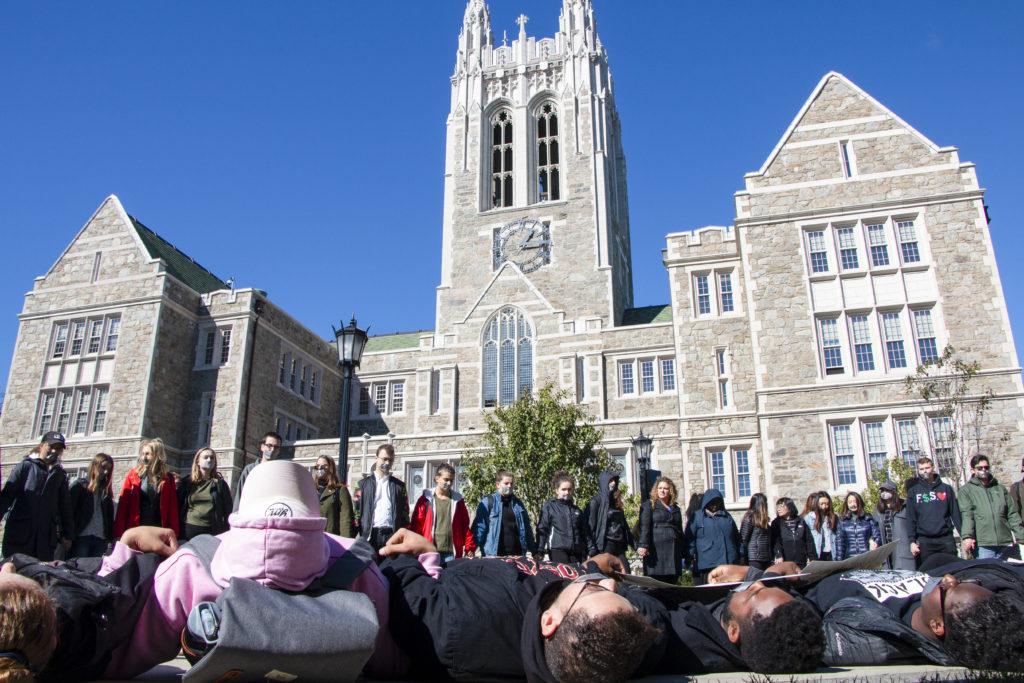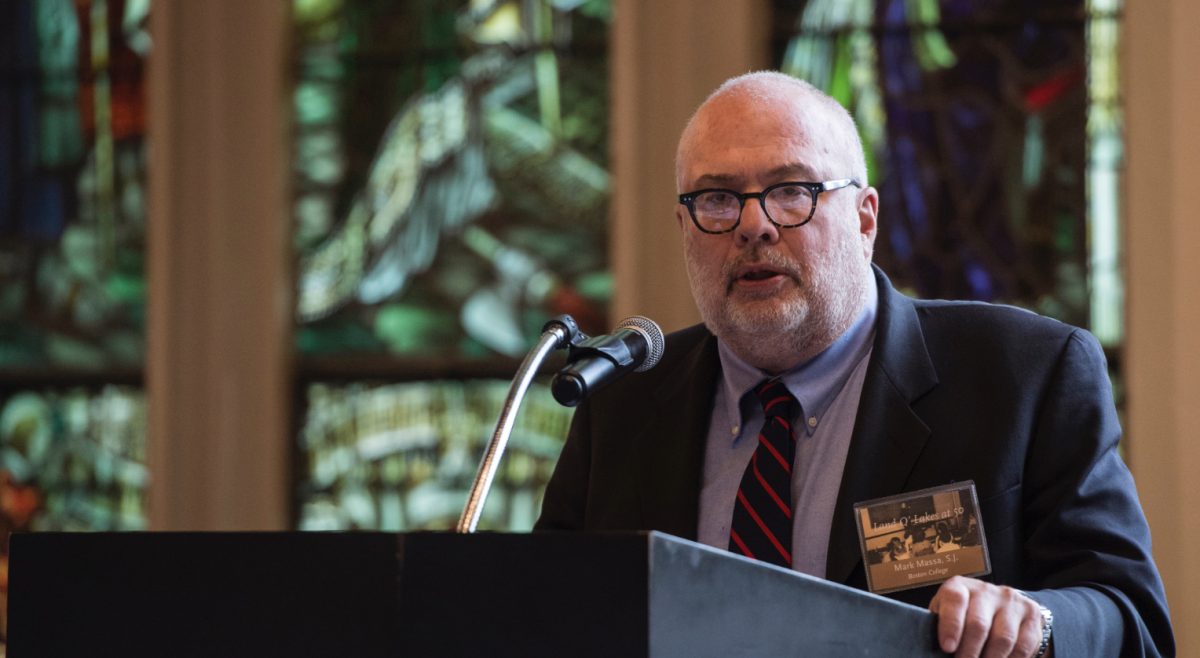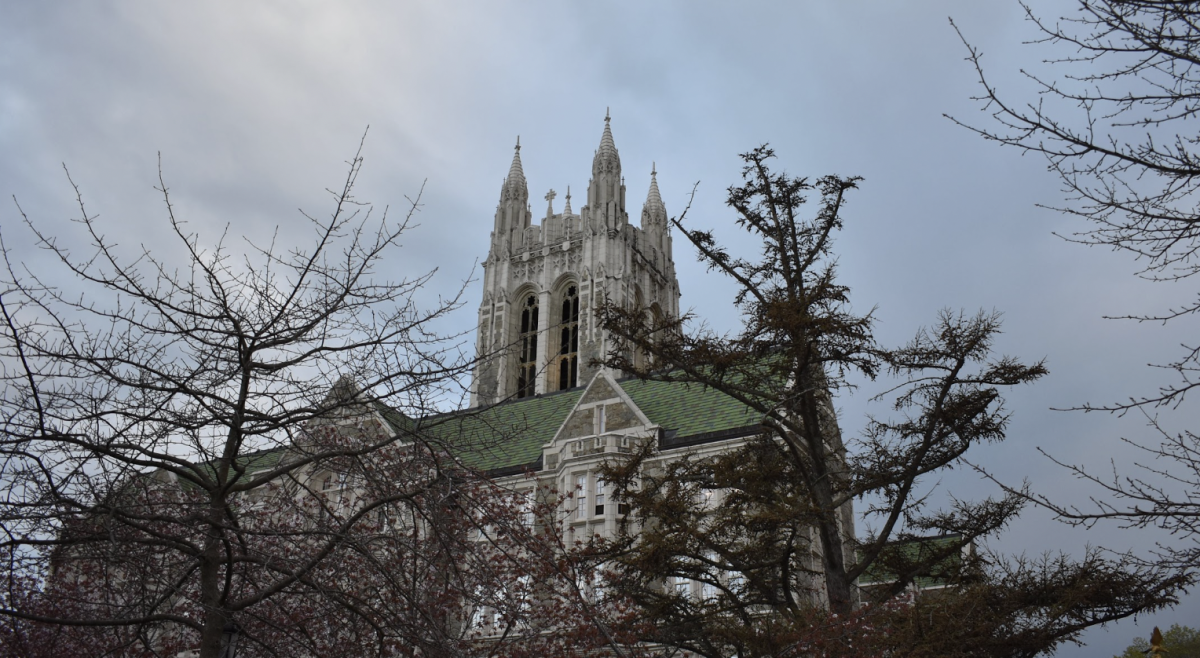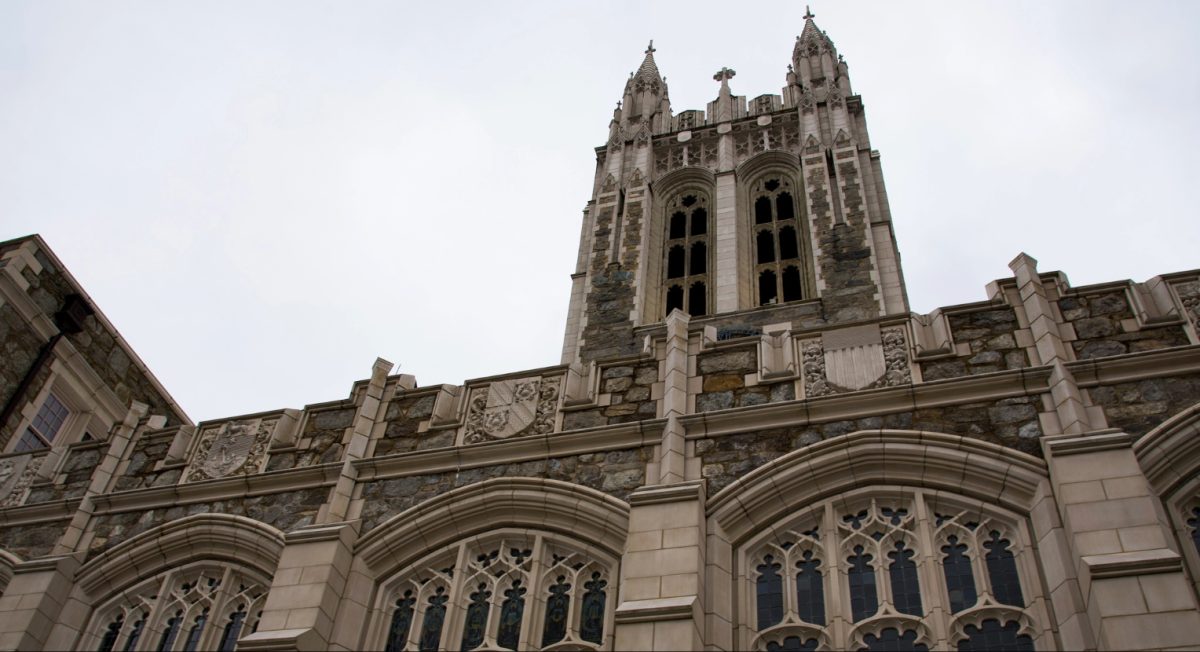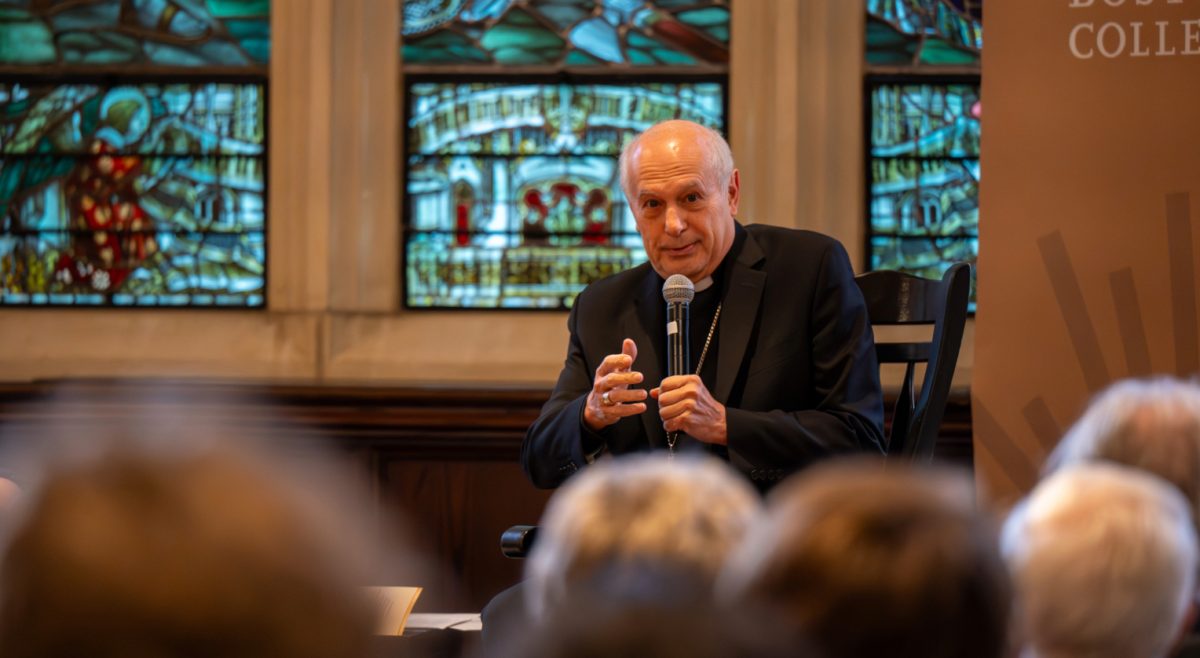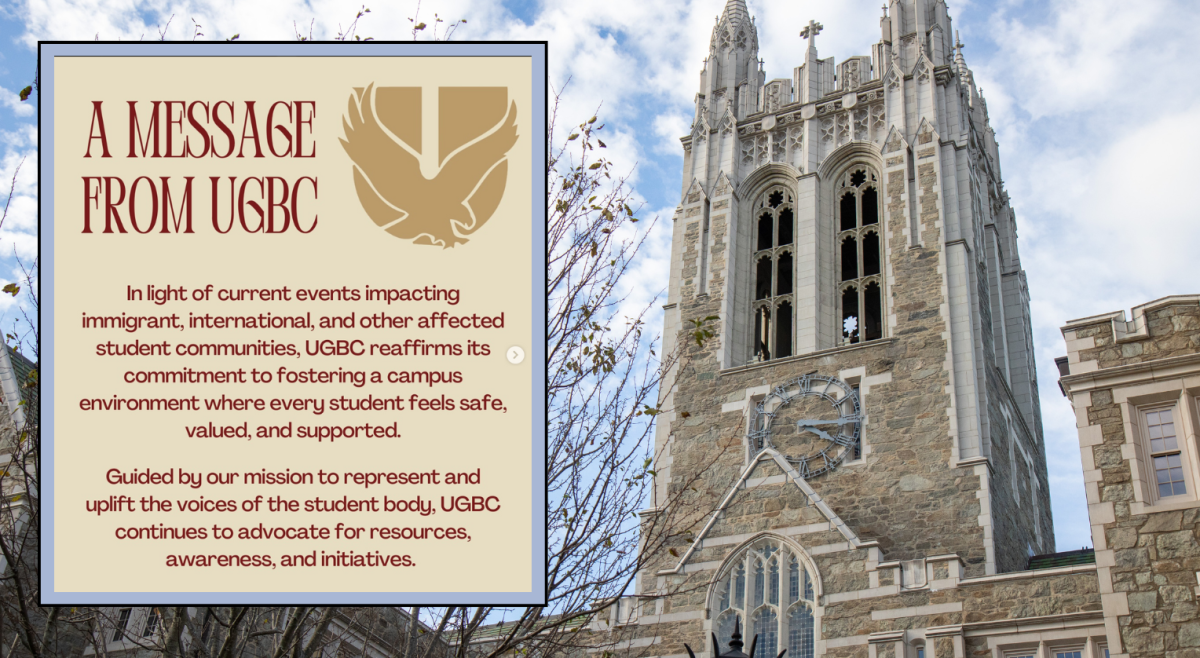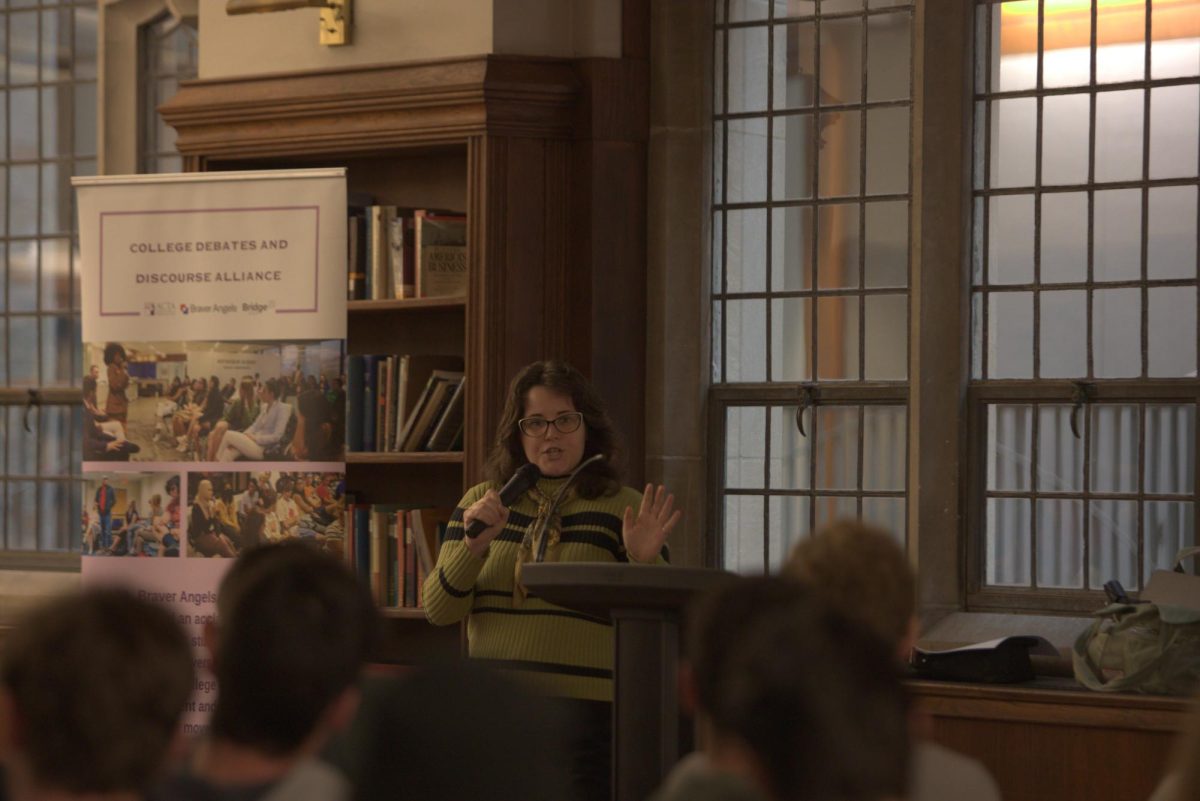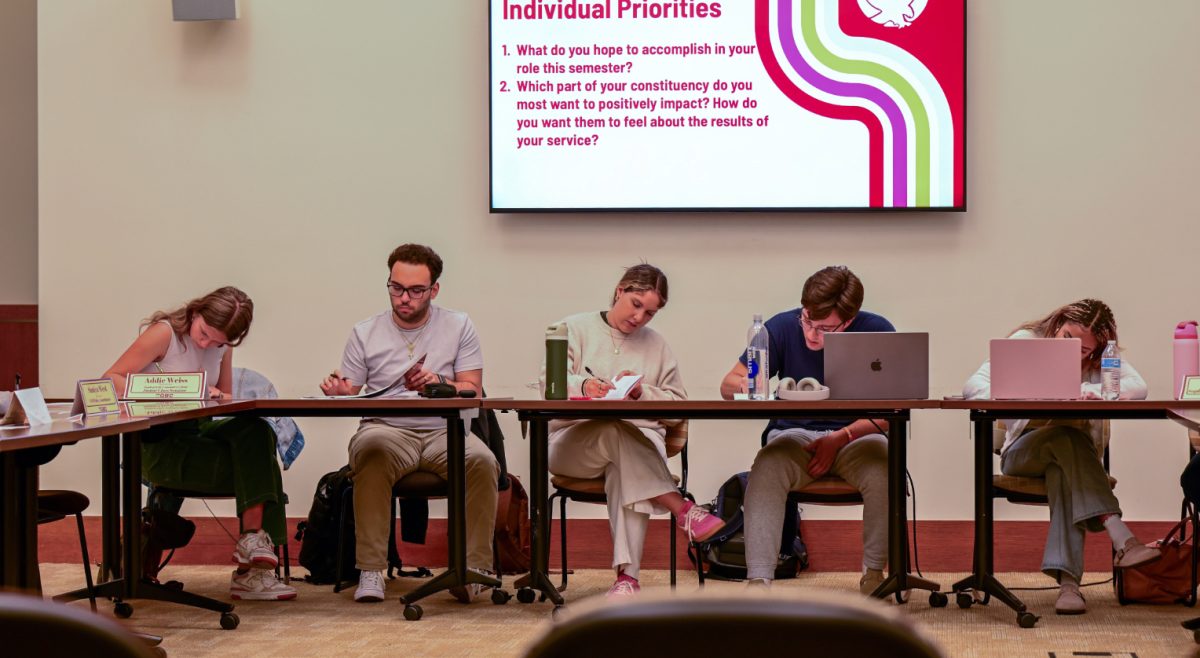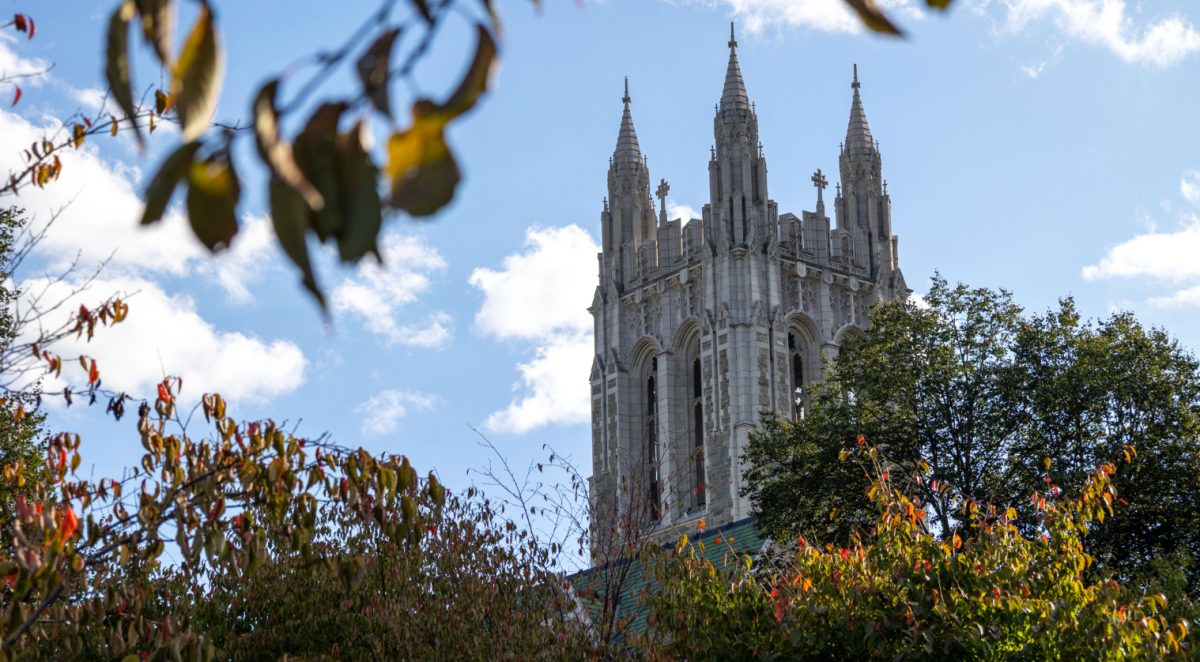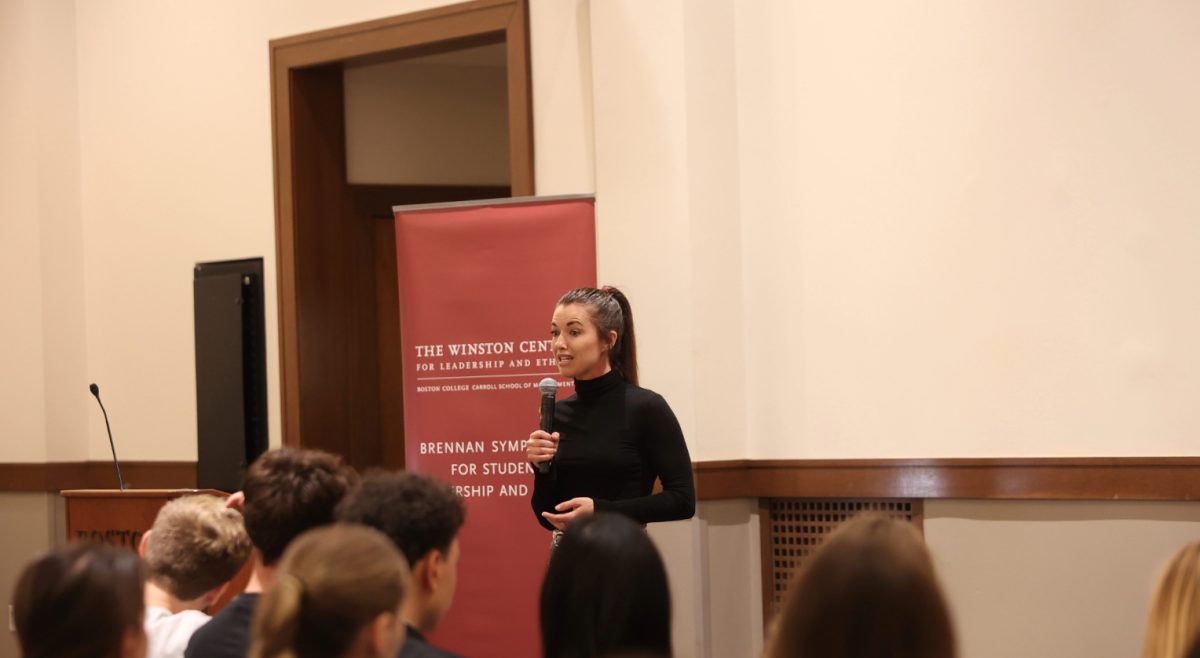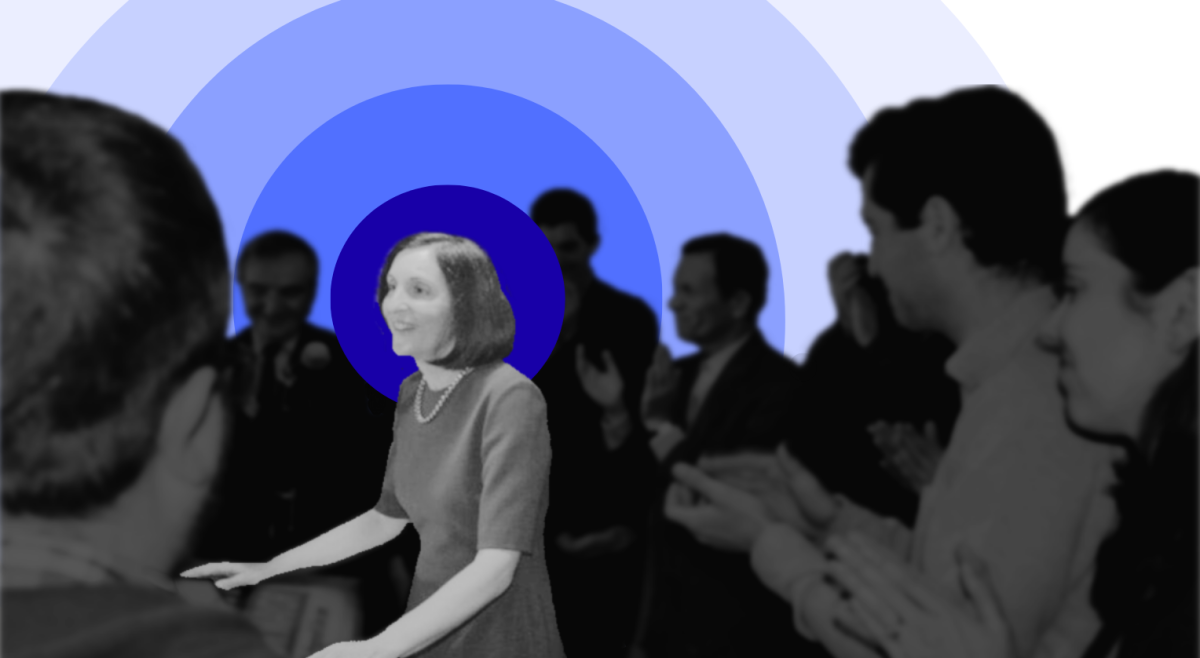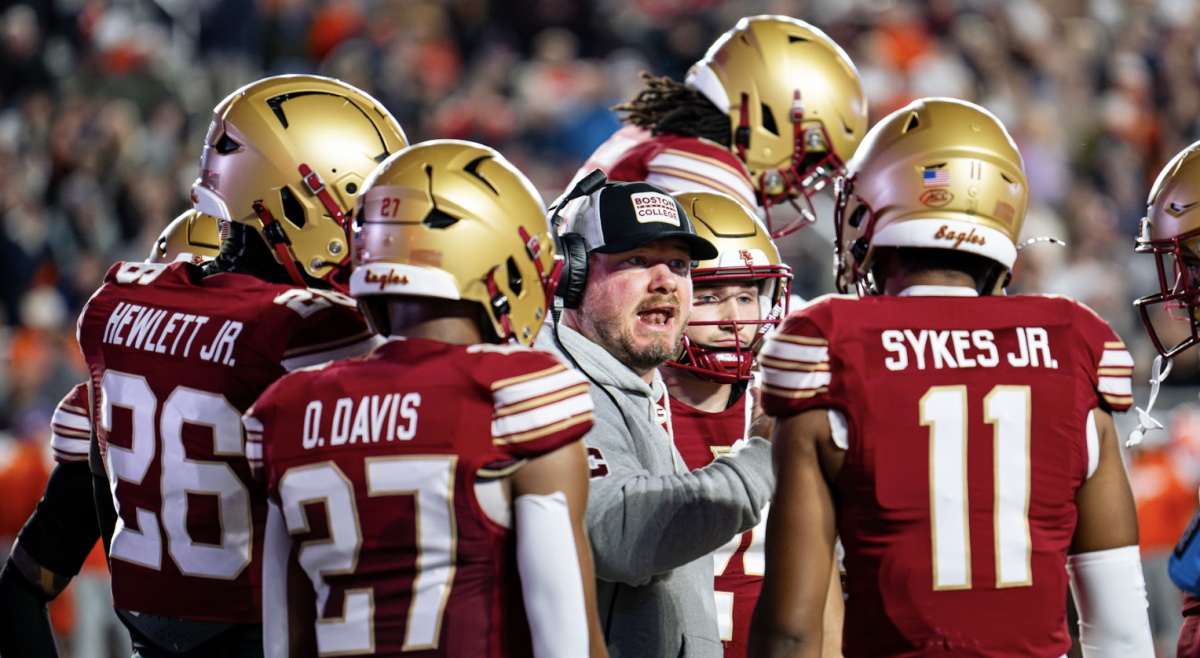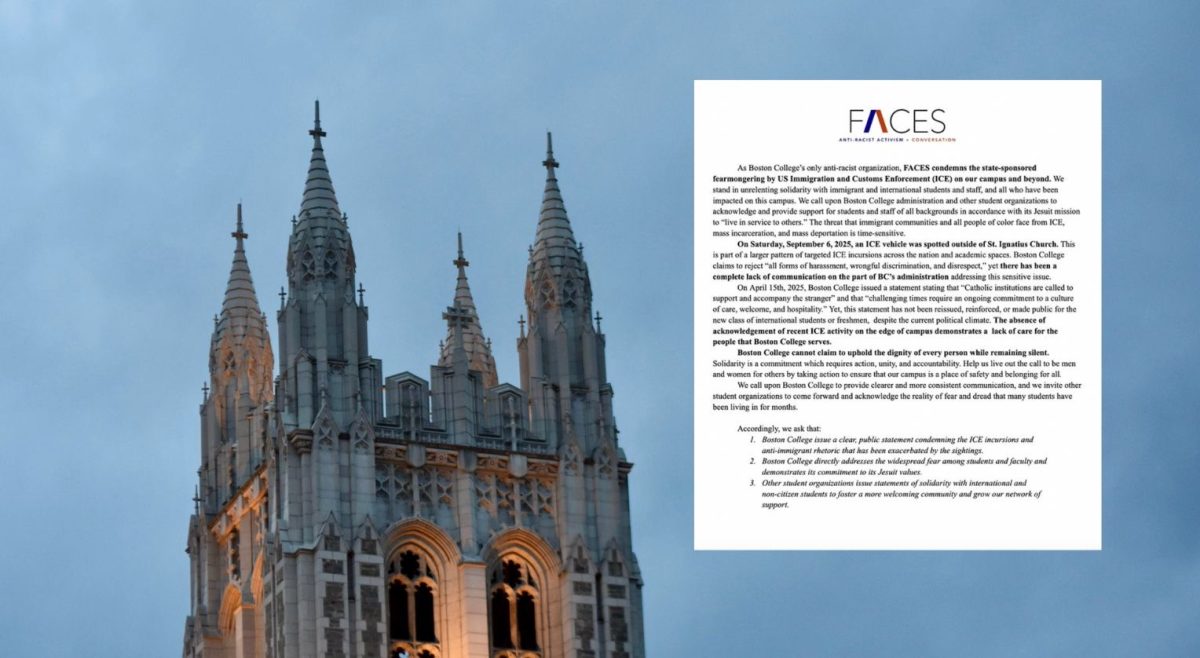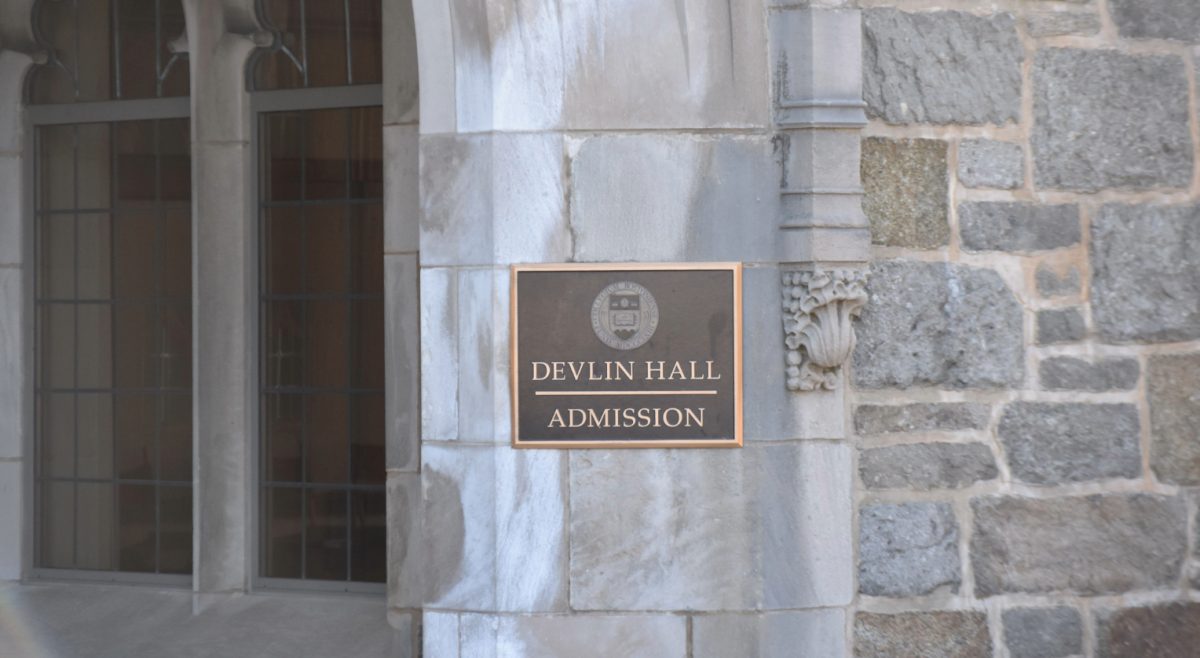Student protesters staged a “die-in” on the Quad on Thursday afternoon to challenge “the various forms of oppression upheld through a culture [of] institutional passivity” at Boston College, according to a release from the Black Eagles, the group that organized the protest.
Over 100 students laid down on the pavement that crosses diagonally between Gasson, Lyons, Fulton, and Devlin Hall, with another 50 student activists holding hands and standing next to those demonstrating on the ground.
The majority of demonstrators taped their mouths shut to show “the institutional silencing that happens at Boston College,” according to the release. Some students also hummed the melody of “We Shall Overcome.”
The demonstration began at 1:05 p.m. with 100 demonstrators and a small crowd surrounding them, but increased to over 150 protestors when class let out at 1:15. Student activists on the ground interlocked arms while those who stood held hands. Signs with messages advocating for fair treatment were laid on the ground, as well as held by some protestors.
University Spokesman Jack Dunn reiterated the administration’s support for students of every background, laying out the steps BC has taken in reaction to the inciting incidents and student outcry that led to the “Silence is Still Violence” march and movement.
“All of us within the BC community condemned the racial incidents that occurred on campus last October, and BC administrators have worked closely with student leaders during the past twelve months to address mutual concerns regarding diversity and inclusion,” Dunn said in an email.
Dunn noted that the collective efforts of administrative and student leaders led to the creation of the DiversityEdu module and the Student Experience Survey that will be emailed to undergraduate students on Oct. 29. He also said that discussions between administrators and student leaders regarding diversity and inclusion matters have continued and will continue to take place.
Details on the survey were not made available to The Heights, but Dunn indicated that more information regarding the contents of the survey will be made available to students before its release.
The Black Eagles released a set of demands Thursday evening in a letter addressed to University President Rev. William P. Leahy, S.J.; Rev. Jack Butler, S.J., vice president of University Mission and Ministry; Patricia Lowe, executive director for institutional diversity; interim vice president of Student Affairs Joy Moore; Dean of Students Tom Mogan; and Provost and Dean of Faculties David Quigley.
“We, as students of Boston College, are not responsible for solving structural inequity,” the letter said. “Rather, we recognize the places for advancement in our community here at Boston College and are open to active listening. Despite this, we are exhausted of the repetitive and cyclical conversation.”
Moore made it clear that despite never joining an on-campus protest during her time at BC, she can still relate to what led to students feeling the need to demonstrate.
“As an AHANA alumna, my Boston College journey as a student had its challenges and struggles, but those were far outweighed by the many positive experiences and encounters I enjoyed,” she said in an email. “I made it my mission to be visible and engaged. I never let anyone (a fellow student, faculty member or administrator) make me feel as though I was not welcomed or did not belong in the same way as they did. I had earned my place at BC just as they had and I went about my journey as an equal member of the community. I never felt marginalized because I always placed myself in the center.
“So, I can relate in a deeply personal way to what the demonstration meant to the students who participated. They chose to express their feelings by demonstrating peacefully and that is their right.”
The Undergraduate Government of Boston College committed its support to students protesting on campus, especially those that protested for the rights of students marginalized on campus.
“While Boston College students have expressed a need for more comprehensive diversity, equity, and inclusion programs for decades, the events of last fall made it painfully clear that the University still has a long road ahead,” UGBC’s executive council said in an email statement to The Heights. “As such, UGBC fully supports efforts like Thursday’s protest on the Academic Quad, that strive to keep systemic racism at the forefront of campus dialogue. The “die-in” served as a visually salient way of drawing attention to the continued fear, discomfort, and discrimination that students of color feel in our community.
“BC administrators have repeatedly expressed their opposition to all forms of prejudice and discrimination; however, statements alone will not succeed in changing our campus culture.”
The Black Eagles recommended that the University work with outside organizations such as the Southern Poverty law Center, the Anti-Oppression Resource and Training Alliance (AORTA), the National Association for the Advancement of Colored People (NAACP), and the Center for Social Inclusion. The Black Eagles indicated their appreciation for the University making efforts to “build a more inclusive community.”
Despite this, the group believes more needs to be done based on the action plan put out by the University on Feb. 6. The Black Eagles criticized the DiversityEdu module “for its lack of intentionality in terms of content.” The group also said it lacked the ability to facilitate reflection on “individual, community, and interpersonal experiences,” as well as “accountability mechanisms.” In letting students know that their answers would not be recorded, the module was made to be counterproductive, according to the Black Eagles.
Moore said in an interview with The Heights last week that the committee that initiated DiversityEdu, which was made up of students, faculty, and staff, understood that this was an introductory step that would not solve every diversity issue on campus. She indicated that the module would be tweaked next year to ensure that students can’t circumvent the intended purpose of the module.
The UGBC statement noted that DiversityEdu will continue to be refined and improved based on student feedback, and that BC entered into a two-year contract with the company that put together the DiversityEdu module—in the hope that BC students would take the wheel in regards to creating the University’s own, individual module.
The Black Eagles also requested that the University continue to work on diversifying its staff. Specifically, the group asked that BC work on hiring “high ranking administrators of color to present the perspectives that are simply inaccessible to our current administration.” They also asked that the administration prioritize hiring black and Latinx professors within their efforts to hire AHANA+ faculty. The Black Eagles indicated their consternation with the idea that students can go through the curriculum at BC without taking a class taught by a professor of color.
The Black Eagles asked that BC introduce a platform that will transparently disclose hiring details. The group criticized the Carroll School of Management, the Connell School of Nursing, and the Morrissey College of Arts and Sciences for not hiring a more diverse group of professors—they specifically cited deficiencies in the hiring practices of the STEM departments as being problematic.
In an interview with The Heights this past September, Vice Provost for Faculties Billy Soo said that the varying number of openings makes it difficult to overhaul the diversity profile of the University overnight. He also noted that the pipeline of AHANA+ candidates is hard for BC to establish because of a nationwide demand for faculty of color—there aren’t enough qualified candidates to fulfill that demand.
The Black Eagles called for further support for the African and African Diaspora Studies (AADS) program. They asked for more resources, hiring control, and an increase in course offerings. The group also asked that the academic constrictions inherent to the program’s current setup be altered to be more student-friendly.
UGBC’s Executive Council noted in its statement that it has received “encouraging” updated from Quigley in regards to creating a full-fledged department for AADS.
“While we cannot say for sure whether it will be available by next year, we know that it is in the works,” the council said.
The Black Eagles also called for the campus climate survey to be announced and for details to be released on what the survey will contain. Before this article was published, there had not been a public disclosure of the survey’s impending release, although administrators had indicated that the survey was in the works in the past. The Black Eagles specifically criticized the administration and committee responsible for putting the survey together for not giving a “clear timetable” in regard to when the survey will be released to BC students.
Finally, the Black Eagles requested that the University put together a plan for a student center that students will have an opportunity to utilize in “the foreseeable present.” In the meantime, the group requested that intersectional resources be made available for students.
“Ultimately, the hope is that Boston College is continually working on the above goals and more to enhance the student experience,” the Black Eagles’ release said. “However, there is a lack of transparency with said plans with the student body. There needs to be a constant stream of communication.”
The group closed by requesting a town hall meeting with administrators that would be open to the student body, faculty, and staff—they requested that this meeting take place by the end of November with a follow-up in the spring.
Administrators say there is a sense of confusion surrounding the idea that students should be “scared” of conversations with administrators about racial issues, which was referenced in the Black Eagles’ release. Administrators felt that with the creation of DiversityEdu and the upcoming Student Experience Survey, the University is working to try to bridge the gaps in understanding between it and students of different backgrounds by providing resources and listening to student requests.
Moore commented more specifically on her thoughts relating to student fears.
“I am sorry to hear that some students say they are afraid to enter into conversations with administrators,” she said. “All administrators are open to having conversations with students about racial issues and many do on a regular basis. They are committed to listening, learning and working together to improve our campus climate around diversity and inclusion.”
That communication is, beyond DiversityEdu tweaks, the Student Experience Survey, and the Provost Office’s work on diversifying the University’s pool of faculty, the primary step Moore will be concentrating on in the wake of the “die-in.”
“I would like to continue meeting with students and listening to their stories and experiences,” she said. “I would like students to be able to share with me and other administrators additional strategies to help us advance toward being a more welcoming and inclusive community. I look forward to us making meaningful and significant strides. Patience and grace will get us there.”
Thursday’s protest was approved by the University. Moore and Mogan, as well as representatives from the Boston College Police Department were present.
The demonstration concluded at 2 p.m., when the protestors stood up and removed the tape from their mouths and began to sing “We Shall Overcome.”
The event took place two days before the one-year anniversary of the “Silence is Still Violence” march that took place on Oct. 20, 2017.
This article is being updated. Jack Goldman contributed to this report.

